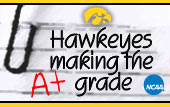- Game Day Live
- 2015 UI Football Fall Camp Central
- Read the November issue of Hawk Talk Monthly
- Download your Hawk Talk Monthly iOS app
- Download your Hawk Talk Monthly android app
- Download your Iowa Hawkeye iPhone/iPad app
- Download your Iowa Hawkeye android app
- Big Ten Network: Free Hawkeye Video
- 24 Hawkeyes to Watch
IOWA CITY, Iowa – Student-athletes at the University of Iowa tied a school record and outperformed their peers nationally in the classroom for the fifth consecutive year, according to data released today by the NCAA.
According to the NCAA’s annual report on the academic successes across the country, student-athletes who entered the University of Iowa in the fall of 2008 graduated at a rate of 89 percent when the rate was calculated using the criteria for the NCAA’s “Graduation Success Rate,” or “GSR.”

|
That mark tied the UI’s all-time high score in the GSR posted last year and was six points better than the GSR for student-athletes at all NCAA Football Bowl Subdivision (FBS) institutions.
Seven UI teams scored a perfect 100 on their GSR: Men’s basketball, men’s golf, men’s tennis, field hockey, women’s golf, women’s tennis, and volleyball. Seventeen of Iowa’s 24 teams posted GSR’s that were better than their peers nationally and two sports that didn’t – football (71) and women’s swimming and diving (92) – missed matching the performance of their peers nationally by just one point.
|
“At the University of Iowa we are committed to winning, graduating, and doing what we do each day the right way. Today’s report is our annual report card on the “Graduate” leg of our three-legged stool and, once again, our student-athletes have delivered.”
Gary Barta, UI Director of Athletics
|
Student-athletes who entered the University of Iowa in the fall of 2008 graduated at a rate of 71 percent when the rate was calculated under the criteria of the federal government’s benchmark for graduation success. The UI’s score of 71 is three points better than the graduation rate for all student-athletes at FBS institutions nationwide who enrolled at that time and marked the fifth consecutive year that the federal graduation rate for student-athletes at the UI has exceeded 70 percent.
The NCAA introduced the GSR in 2005 to more accurately assess the academic success of student-athletes. Unlike the federal graduation rate, the GSR holds institutions accountable for transfer students. The GSR also accounts for midyear enrollees.
“Success in the classroom is a team effort that starts with our student-athletes seizing the academic opportunities available at the UI with the same vigor they tackle their goals in athletics. Their academic successes are also a product of the support they receive from their coaches, our staff, and hundreds of individuals across the UI campus who are committed to the academic successes of our student-athletes,” said Gary Barta, the UI director of athletics.
“At the University of Iowa we are committed to winning, graduating, and doing what we do each day the right way. Today’s report is our annual report card on the “Graduate” leg of our three-legged stool and, once again, our student-athletes have delivered.”
Last spring, paced by three teams that posted perfect Academic Progress Rate (APR) scores, all 24 of the University of Iowa’s intercollegiate athletics programs were found to be achieving in the classroom at a rate that surpassed the national benchmark for success established by the NCAA. It marked the sixth consecutive year that all of the UI’s sports programs were above the APR threshold that signals a red flag with respect to a sport program’s academic progress.
The highlights of the results for the UI include:
Perfect scores of 1,000 for men’s golf for the second year in a row, women’s swimming and diving, and women’s volleyball, and a score of 997 for soccer. These four UI programs ranked among the top 10 percent of their peers.
- Year-over-year increases in 14 of the UI’s programs including football, men’s basketball, and women’s basketball.
- The APR for 17 of the UI’s sports teams was better than the national average for their peer group. The list of 17 included the sports of football, men’s basketball, and women’s basketball.
- The Academic Progress Rate measures eligibility and retention of student-athletes competing on every NCAA Division I sports team. This year’s APR scores are based on a multi-year rate that averages scores from the 2010-11, 2011-12, 2012-13, and 2013-14 academic years.
The goal of the NCAA’s academic performance program is improvement, not punishment. Not only does the program ensure accountability for student-athletes, teams, and institutions, but it also provides fairness by considering individual circumstances per team and school. This year marks the 11th year of APR data for most teams.



